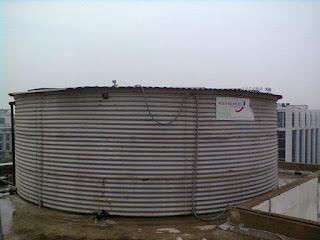GLS/GFS TANKS REPAIR
GLS or GFS tanks are made by combining two materials: Glass and steel.
After getting combined, they both give the highest level of flexibility,
durability and corrosion resistance. The GLS tanks are largely used in the tank
market for storing biogas energy or treating the municipal and industrial
wastewater. Along with these, they also help in purifying and sledging and also
able to store oil or drinking water.
The high temperature melting of glass to steel fired against the
850-degree results in an inert and durable finish. Applied both indoors and
outdoors, GFS technology can withstand the rigorous of the construction site
and provide many years of trouble-free service in harsh environments.
In the process of using the tank, a number of factors influence the
operational reliability:
-
·
External environmental influences;
One of the main problems of tank operation, which can be prevented at
the design stage, is metal corrosion. The inner surface of containers is most
exposed to corrosion. We all know that GLS tanks are made from a good
anti-corrosive material, and they are relatively resistant to the atmosphere,
water, and common concentrations of acids, alkali's, salts, and various oils and
solvents, but still, it is important to keep them away from corrosion-prone
areas so that they can work for a longer time period.
In order to maintain GLS tanks in a healthy state, between major
repairs, their timely and high-quality maintenance and current repairs should
be carried out. Maintenance is carried out according to the instructions of
manufacturers, industry guidelines and instructions for the operation of tanks,
equipment, instruments, systems, developed taking into account the specific
conditions of the enterprise or its branches.
·
External environmental influences;
·
Exposure to the stored product;
·
The regularity of maintenance;
·
Qualification of repair and maintenance personnel.
Some of the things you can do for the proper maintenance of repair of GLS/GFS tanks are listed below:
- First, the GLS tanks should be inspected periodically during use. If glass-lined fragments are found in the discharged material, the inspection should be carried out immediately. If the glass-lined partial damage is found, it must be repaired in time before use. In order to avoid the accident caused by the expansion of the damaged part; the materials stuck on the inner surface of the tank should be cleaned in time, and metal tools should not be used during cleaning to prevent damage to the glass-lined porcelain layer.
- If the discharge port of the GLS tank is blocked, you can use wooden sticks, rubber rods, and other soft objects to clear it. It is strictly prohibited to scrape the blocked glass-lined tube with metal and hard tools;
- When maintenance personnel enter the GLS tank for inspection, the bottom of the tank should be covered with a thick and large cushion to prevent the tools from falling into it, and the maintenance personnel should wear rubber-soled shoes or plastic shoes to avoid damage the porcelain surface;
- The GLS tanks should be cooled with frozen brine, and the inlet and outlet valves cannot be closed during shutdown; because in the sealed state, the volume of the frozen brine will increase after the temperature rises, which will generate very high pressure, which will cause strong pressure on the tank. The equipment is scrapped.
- When cleaning the inter layer of the GLS tank, it is strictly forbidden to use strong acid and alkali, because the inter layer enters the strong acid and alkali, which will cause a hydrogen explosion in the tank.
- After using the glass-lined tank equipment for a period of time, it should be regularly painted with anti-rust paint. The glass-lined equipment that is not used or is temporarily not used should be stored and protected from bumps and rain. In winter, the tank and inter layer should be put away. Water to prevent icing and collisions from causing the porcelain layer to swell.
- Tighten the bolts evenly and symmetrically during installation and tighten them 2 to 3 times to prevent the bolts from skewing and damaging the sealing gasket to affect the sealing effect.
Glass-lined storage tanks are mainly used to store chemical raw
materials, have strong corrosion resistance, and are commonly used equipment
for chemical raw material storage. Glass lined storage tank is one of the main
products of the tank market. It has a very good use effect and very high
efficiency. People who are in need can contact the best manufacturers to
discuss and negotiate.
Although glass-lined steel tanks are corrosion-resistant and
wear-resistant equipment, you must also pay attention to prevent metal or
debris from entering the equipment when adding materials, prevent damage to the
equipment, and damage the glass-lined appearance, increasing the cost of the
enterprise.
To ensure that the over usage of the glass-lined steel tank can degrade
the performance of the equipment, it must be operated in accordance with the
above repair and maintenance standards. It is possible that the GLS/GFS tanks
will start working in a weird way because of the over pressure and corrosion of
the vessel wall. Therefore, it is usually necessary to pay more attention to it
and do maintenance work to prevent some outbreaks.
The accessories of GLS/GFS tanks should be checked regularly. If you
find any issue in the tank, that particular accessory should be disassembled
immediately and replaced according to the structure diagram.









hi, we have GLS hopper tanks leakage from the the cone side bolts and lap joints. is it necessary to repair first and it is necessary to stop leakage mechanically before lining. we believe that after lining the leakage will be stopped.
ReplyDeleteAs per the standard, hydrotest is mandatory before lining?